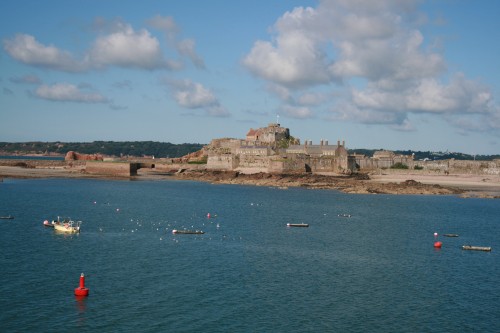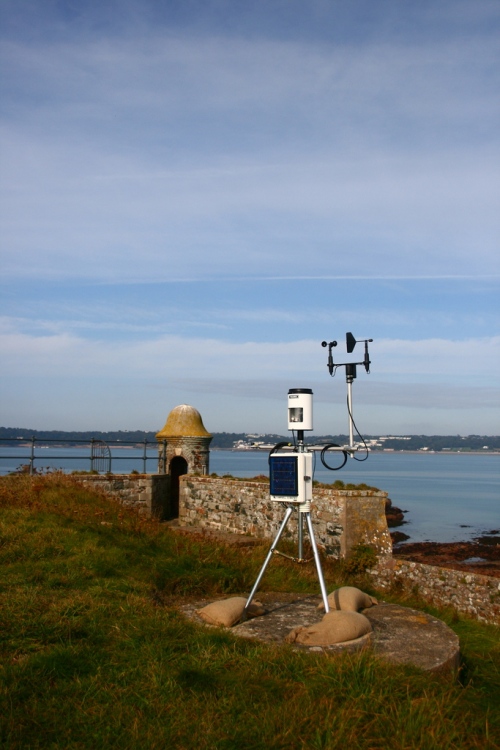Archive for 2011
mark ballora discusses data and sonification, featuring a lovely audio rendition of weather parameters http://t.co/39cAstKQ
Friday, 16 December 2011
this season’s soho house magazine features an interview on variable 4, now available online and as a pdf (p17/18): http://t.co/UTLc7S9v
Friday, 16 December 2011
After Variable 4 Elizabeth Castle
Over the Channel to Jersey, and across the St Helier causeway to the ramparts of Elizabeth Castle, the recent four-day Variable 4 installation at Branchage was a true adventure. We inhabited the castle (below) for almost the duration, housed in a WWII bunker beneath a grassy verge, overlooking oceanic vistas and craggy rocks.
Though we were continually buffeted by the promontory’s unceasing winds, Variable 4 has yet to break its curse of rainlessness: four consecutively dry days made for a temperate installation. Thanks to everybody who came to visit, and to all of the team at Branchage for their endless support.
We also owe thanks to BBC Radio Jersey, who replaced their normal MW programming with a continuous 18-hour marathon transmission of Variable 4. Possibly a first to be able to tune in on medium wave to the sound of weather-driven generative music. Apologies to any local listeners who wondered where your normal programming had disappeared to…
looks like wolfram alpha can generate useful graphs of historical weather conditions: http://t.co/GJqEZLf4
Wednesday, 26 October 2011
mark nystrom’s automated drawings based on wind conditions are things of beauty: http://t.co/PkwItQJB (via @mariuswatz)
Saturday, 8 October 2011
we urge everybody to sign this petition to save coastguard maritime rescue stations under threat: http://t.co/ZsMhAsq0 (via @RomneyHoy)
Thursday, 29 September 2011
really nice video report about the piece on itv channel tv @channelonline: http://t.co/efZnr27A
Wednesday, 28 September 2011
many thanks to @branchage and to all the people who came down to visit. an unbroken record of four entirely rainless installations!
Wednesday, 28 September 2011
magical times as the @branchage folk walked across the causeway to visit us late tonight. nighttime movements still broadcasting on 1026mw.
Saturday, 24 September 2011
high tide, and we’re alone on elizabeth castle island. exploring the 6thC hermitage & neighbouring ww2 bunkers. http://t.co/hgU0Yw13
Friday, 23 September 2011
… possibly the first 24-hour BBC broadcast of a piece of generative music?
Friday, 23 September 2011
for those in the jersey vicinity, tune in to 1026MW to hear variable 4 on bbc radio, broadcasting continuously for the next 24 hours…
Friday, 23 September 2011
we’re now operational at @branchage, with our first night spent within elizabeth castle’s walls. blustering winds not dropping below 3m/s.
Friday, 23 September 2011
beat the crack of dawn to portsmouth harbour, now at the freight terminal for the channel islands ferry… http://t.co/73Rg53yZ
Tuesday, 20 September 2011
the live weather conditions of jersey can also be tracked via: @LiveWeatherJSY
Friday, 16 September 2011
the happy recipients of detailed historical data from jersey meteorological department (http://t.co/CS3SZqgW). and now: analysis friday.
Friday, 16 September 2011
charming rendition of the weather forecast as an anglican chant: http://t.co/KCoSUJ5
Wednesday, 14 September 2011
announcing the third appearance of variable 4! elizabeth castle, jersey, as part of @branchage (22-25 sept 2011) http://t.co/zXouE7S
Wednesday, 7 September 2011
Variable 4 Elizabeth Castle
It’s with great pleasure that we can announce the third appearance of Variable 4 — and the first overseas (albeit still within British territory). From 22nd to 25th September 2011, the piece will be installed at Elizabeth Castle, Jersey, in conjunction with the Branchage film festival.

This also the first time that the piece has operated over several days, running for roughly four days between 22nd and 25th. This is pretty exciting for us, as it means exposure to a much wider range of weather conditions.
Elizabeth Castle itself is just off the coast of St Helier, over a causeway which submerged outside of low tides. For the remainder of the time, it’s accessible via an aquatic vehicle (below). We’re already relishing the thought of loading up a van-full of meteorological and A/V equipment onto these little boats…

Though sponsored by the festival, access to the installation itself will be free, bar the cost of the ferry trip.
unbelievable wind-driven walking sculptures, by dutch artist theo jansen http://t.co/5K5Vrm6 (via @kathryncorlett)
Wednesday, 7 September 2011
Public beta release of Isobar, a Python library for algorithmic composition
Underlying Variable 4 is a suite of Python code, with components to deal with various different tasks – interfacing with the weather station, navigating the global score, broadcasting data, and so on. There’s one part in particular that we’ve found useful in general usage: the pattern generation code, which can be used to describe, manipulate and generate sequences of musical events.
We’ve finally cleaned this up for public release, and have christened it Isobar, from the notation used in meteorological pressure systems. In this context, it’s a way of notating music, in a concise and flexible manner.
Overview
Isobar is a pure Python library which makes it easy to express musical patterns, and output them through MIDI or (soon) OSC devices. It’s inspired by SuperCollider’s excellent pattern library, which allows patterns to be combined like building blocks to create easily extensible compositions.
To get it: download Isobar from GitHub.
Please note that this is a beta release, meaning that all features and syntax are subject to change.
Examples
To give a taste of Isobar’s approach and capabilities, let’s look at some example code
from isobar import *
seq = PSeq([ 0, 1, 2, 3 ])
seq = PStutter(seq, 2)
seq = seq + PSeq([ 0, 12 ])for n in xrange(8):
print seq.next()> 0
> 12
> 1
> 13
> 2
…
The above creates a simple looping sequence (PSeq) based on increasing integers (or, if used as MIDI outputs, chromatic notes). Each value is repeated once (PStutter), and alternating notes are transposed an octave up. This is then used to output a sequence of numbers.
Note that patterns can simply be added together to transpose values. Many other operators can be applied in similar ways: for example, doing seq * 2 will double every value of a pattern, using lazy evaluation for no additional processor usage.
from isobar import *
from isobar.io.midiout import *scale = Scale([ 0, 2, 3, 7, 9, 11 ])
degree = PBrown(0, 2, -8, 8, repeats = False)notes = PDegree(degree, scale) + 60
midi = MidiOut()
timeline = Timeline(160)
timeline.output(midi)timeline.sched({ ‘note’: notes, ‘dur’: 0.25, ‘gate’: 0.9 })
timeline.run()
This example binds a pattern to a MIDI device, and uses a random walk (PBrown) to play values from a particular Scale. A Timeline object is used to schedule MIDI events at a given BPM, and plays them through the default MidiOut device.
By assigning this pattern to the ‘notes’ value, its output is used to generate a series of pitches. We could assign a separate pattern to the ‘amp’ value, to control the velocity of each note.
Many more examples are available in the isobar distribution on GitHub, with an up-to-date index of pattern objects in the README. We’ll be continuing to work on Isobar extensively over the next few months; see the TODO file for forthcoming developments.
Film: Introduction to Variable 4
Fresh from the cutting room, this short documentary film explains the concepts and infrastructure behind Variable 4. With beautiful footage by filmmaker Drew Cox, and soundtracked by excerpts from the Snape Maltings installation, we hope it gives a much more illuminating overview than a description ever could.
Thanks also to the Creators Project, for recently featuring this video (and an interview) on the Creators Project Blog.
weather blog Cliff Mass on irene and what makes a hurricane: http://t.co/1DxqKSX
Tuesday, 30 August 2011
cloud formation study casts a shadow over certain climate models http://t.co/riljoXg
Thursday, 25 August 2011
we’re also delighted to have been featured on the @CreatorsProject blog: http://t.co/7iOkwBo
Thursday, 11 August 2011

